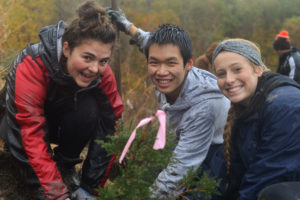It’s not the long hours, scorching summer afternoons, or a luxurious salary that beckon our volunteers into Cuyahoga Valley National Park. There is another, more meaningful and worthwhile element that pulls them in. This is part of the value of our park—beyond recreation and education, there is an opportunity for meaningful service.
Here in CVNP, the Volunteers-in-Parks program—co-managed by the Conservancy—helps people of all ages forge a connection to the Cuyahoga Valley. These CVNP volunteers are instrumental in how the park is able to carry out its mission each and every day. We value the park volunteers all year round, but National Volunteer Week is an opportunity for us to highlight the remarkable work that they do to preserve and protect our national park.
In 2017, over 7,000 volunteers served Cuyahoga Valley National Park and provided 205,000 hours of service. A portion of these volunteers resurfaced more than 12,500 feet of trail and improved and installed 259 trail features, which are modifications to a trail that help improve them in some way.1
Volunteer Highlight
One of these volunteers, 24-year-old Shemaiah Sturdivant, started volunteering for CVNP in late 2015. Shemaiah has a huge love and passion for the National Park Service and wanted to be involved any way she could. She has helped with events in the Cleveland area and in the park, such as trail clean-up days.
“Volunteering has given me the chance to share something that I love so much with other people, and hopefully by introducing them to the National Parks, I’ll help them find something they’ll love too,” Shemaiah said.

Shemaiah believes that becoming a volunteer is just as important as donating money.
“Showing up and being actively involved in your park is so important,” Shemaiah said. “It shows a kind of selflessness that even though there isn’t any monetary value attached to the time you give, the lasting effect is priceless.”
Impact of CVNP Volunteers
To better illustrate the impact that they have on Cuyahoga Valley National Park, let’s explore what couldn’t happen if we didn’t have such a large number of highly committed volunteers:
- Volunteers improve habitat for wildlife by planting native trees, shrubs, and flowers, and also by removing invasive vegetation. These animals and plants rely on our volunteers for a healthy life.
- Volunteers provide important safety patrols on the Towpath and other trails. Emergency response and information for visitors would be hugely impacted without volunteers.
- Numerous educational displays are set up in the park and throughout northeast Ohio to educate people about the park, and these displays are staffed solely by volunteers. The park would be far less known without volunteers.
- Volunteers staff visitor centers, assist with educational and interpretive programs, and help in park and partner offices. We would see reduced hours of public interaction without volunteers.
- Cuyahoga Valley Scenic Railroad is dependent on volunteers for its operation. It could not provide service at a reasonable cost without volunteers.
What an incredible difference these volunteers make in the day-to-day operation of Cuyahoga Valley National Park! We have one of the largest national park volunteer programs in the country. This is truly something to be proud of.
Making your own difference
Winston Churchill once said, “We make a living by what we get, but we make a life by what we give.”
National Volunteer Week is an excellent time to think about how you can make a difference for CVNP, its inhabitants, and its users. By becoming a volunteer for our national park, you will leave a long-lasting impression for not only your generation, but future generations to come. There is a place for everyone regardless of age to find their volunteer niche. Visit our volunteer page to discover all the options that are available, from drop-in events to group opportunities.






